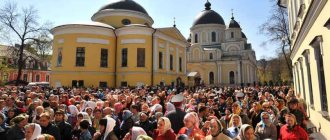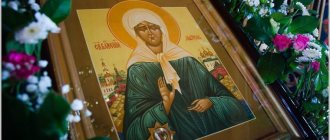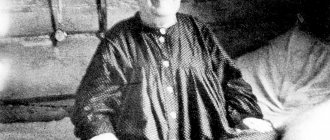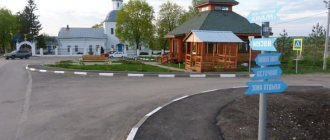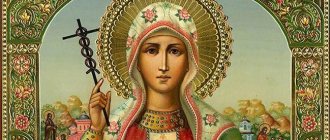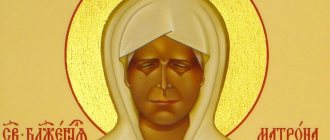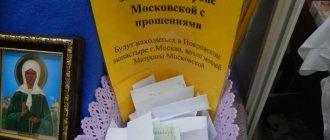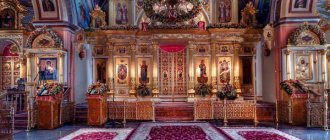Every true Christian who righteously believes in God knows what the relics of Matrona are. After all, this great shrine has been one of the most revered in the whole world for many years. Thousands of pilgrims come to her every day to pay tribute to the blessed one and ask for help in worldly affairs. She is not just an Orthodox saint, she is a symbol of eternal miracle and gracious faith in the Lord, which has no end and edge in the souls and hearts of people.
This article will tell you how to venerate the relics of Matrona of Moscow in order to obtain the desired blessing.
Reliquary with the relics of Matrona of Moscow in the Pokrovsky Monastery
Where are the relics of Matrona kept?
First of all, anyone who wants to touch the greatest shrine of the Orthodox world needs to know in which monastery the relics of the Matrona of Moscow are located. This place has long since become truly miraculous, and every self-respecting Christian knows its address by heart.
Pokrovsky Convent of the Holy Matrona of Moscow in Moscow
They are located in the temple on the territory of the Intercession Monastery and were placed there in 1998 at the insistence and blessing of Patriarch Alexy II from the opened grave of Matrona. First they were delivered to the Danilovsky Monastery, and then transferred to their current destination. The relics are kept in a silver tomb (shrine), and access to them is open daily from morning until late evening.
Pilgrimage
Having the gift of God, Matrona saved many people and was very kind to them. She had a bright face and a very gentle voice. She would pat everyone on the head, console them, and apply her sign of the cross, and this made people’s souls feel lighter, they were comforted and calmed down. Although she herself was very sick, no one heard any complaints from her.
Being very young, Matrona, together with the daughter of a local landowner, Lydia Yankova, made a pilgrimage to holy places. They visited the Kiev Pechersk and St. Petersburg Trinity-Sergius Lavras, as well as other holy places in Russia.
Matrona also visited the Kronstadt Cathedral in 1899. There, the Monk John of Kronstadt, at the end of the service, asked all the parishioners to make way and let Matrona through and said: “Matronushka, come, come to me. Here comes my shift—the eighth pillar of Russia.”
How to get to the relics of Matrona of Moscow
Pokrovsky Convent (Church on Taganka) is located at the address: Moscow, st. Taganskaya 58. You can get to it by public transport, for example, by metro.
Directions: to the metro station “Marksistskaya”, exit to the street. Taganskaya. Then you can walk to the monastery (15 minutes) or by any transport (bus, trolleybus) to the Bolshaya Andronevskaya stop.
Directions: to the metro station “Krestyanskaya Zastava” or “Proletarskaya”, and then 10 minutes walk to Abelmanovskaya Zastava Square.
War
From 1942 to 1949, the Reverend Matrona lived with her fellow villagers - E. M. Zhdanova and her daughter Zinaida. For many years there has been a legend that was described in the book of memoirs of Zinaida Zhdanova “The Tale of Matrona”. During the Great Patriotic War, a serious threat arose that the capital would be captured by the German fascists; Stalin himself came to Matrona. She predicted the victory of the Russian people and said that he alone of all the authorities would not leave and would remain in Moscow. Unfortunately, there is no evidence of this event, but I think it happened.
From 1950 to 1952, she already lived in Skhodnya near Moscow with her distant relatives, the Kurochkins.
The holy elder Matrona predicted her death three days in advance. Being very sick, she still continued to see people. The holy mother died in the spring of May 2, 1952.
Visiting hours
Pilgrims can visit the relics of Matrona of Moscow daily. The opening hours of the temple where the tomb is located are the same as those of the Pokrovsky Convent. Visiting hours: Monday - Saturday from 07.00 - 20.00, Sunday from 06.00 - 20.00.
It is better to come to the relics of St. Matrona on weekdays; on weekends the queue is several times longer; you can stand for up to 6 hours. If you come with a child, you can skip the line to see the large icon and relics.
Biography
In November 1881, a girl was born into an ordinary Nikonov family in the village of Sebino, in the Tula province, who was named Matrona. She became the fourth child in the family, as she already had two brothers and a sister. Poor Matronushka was born blind, and they already wanted to leave her in an orphanage. However, the mother had a prophetic dream: she saw a beautiful white bird that sat on her chest, which had no eyes. The parents guessed that Matrona would become God's chosen child by the beneficial cloud of smoke at the moment of her birth. Already at the age of eight, she had a strong faith in God, and soon the gift of a wise seer was revealed. Crowds of people began to come to her for help and healing. Matronushka became a real breadwinner in her family. And at the age of 18 her legs became paralyzed.
How to venerate the relics of Matrona of Moscow?
Many feel the desire to venerate the relics of Saint Matrona
Many of us visit temples from time to time. But not many of us know how to behave in these church buildings. There are certain rules in order to know how to behave in such places. When you are in front of the relics of a saint, you need to know how to approach them correctly.
So, how to venerate the relics of Matrona:
Behavior in the temple should be the same as in other temples and should be venerated in the same way as other relics. Initially, wait your turn and cross yourself twice. You can also do this with bows.
Then touch the shrine with the relics first with your lips and then with your forehead. After this, cross yourself again and step aside. Remember that there are a lot of people willing and they simply won’t let you stand there for a long time. That is why clearly formulate your requests.
You can take the icon of the saint with you and attach it to the relics. Write notes at home in free form so as not to waste time there.
After you leave the relics, do not forget to approach the clergy for the flowers that are blessed on the relics.
Also, the most wonderful gift from Matronushka for women will be a scarf. There is a very large selection of them! And also buy yourself an icon. May she always be with you and protect you.
But remember that we must not only ask, but also thank the saints for their favor to us. So don't ever forget about this. God bless you!
Matrona Moskovskaya Address: St. Taganskaya, 58, building 12 109147 Moscow,
Phone: +7 495 911–26–07, Fax: +7 495 911–26–07, Email: om
Whom does the Holy Blessed Matronushka help?
People in different life situations ask the saint for intercession. Matronushka helps in healing spiritual and physical ailments, finding a job, strengthening the family, giving birth to healthy children, finding one’s true love, and getting rid of all kinds of addictions. Also, those who cannot find a job for a long time, seek help in their studies, or seek relief from suffering also turn to Matrona for help. The old woman never refuses those asking for help. The main thing is to have strong faith and pray with a pure heart and thoughts.
Before contacting Saint Matrona of Moscow, you need to make a donation to the temple. To do this, bring simple products to the monastery (bread, honey, tea, flour, cookies, nuts, caramels). They can also be distributed to the poor and fed to homeless animals. This is done in the name of God and all saints. Sincere help to those in need will never go without reward, because during her lifetime the old woman herself helped people out of love and compassion.
There are always fresh flowers near the shrine with relics - Matrona loved them very much. Pilgrims can bring with them an odd number of chrysanthemums and lilacs (always white), red tulips, as well as carnations and roses of different colors.
Examples of prayers to Mother Matronushka
Before turning to the blessed elder Matrona with a holy prayer, you need to pray to Jesus Christ and the Most Holy Theotokos.
First
“O blessed mother Matrono, hear and accept us now, sinners, praying to you, who in all your life has learned to receive and listen to all those who suffer and mourn, with faith and hope who resort to your intercession and help, giving quick help and miraculous healing to everyone; May your mercy not fail now for us, unworthy, restless in this busy world and nowhere finding consolation and compassion in spiritual sorrows and help in bodily illnesses: heal our illnesses, deliver us from the temptations and torment of the devil, who passionately fights, help us convey our everyday Cross, to bear all the hardships of life and not lose the image of God in it, to preserve the Orthodox faith until the end of our days, to have strong trust and hope in God and unfeigned love for others; help us, after departing from this life, to achieve the Kingdom of Heaven with all those who please God, glorifying the mercy and goodness of the Heavenly Father, glorified in the Trinity, the Father and the Son and the Holy Spirit, forever and ever. Amen".
Second
“O blessed mother Matrono, with your soul standing in heaven before the Throne of God, but with your body resting on earth, and with the grace given from above, exuding various miracles. Look now with your merciful eye on us, sinners, in sorrows, illnesses and sinful temptations, our days of waiting, comfort us, desperate, heal our severe ailments, from God to us for our sins, deliver us from many troubles and circumstances, pray to our Lord Jesus Christ forgive us all our sins, iniquities and falls, in whose image we have sinned from our youth even to the present day and hour, and through your prayers having received grace and great mercy, we glorify in the Trinity the One God, the Father, and the Son, and the Holy Spirit, now and ever and ever. Amen".
Blessed Matrona prayed loudly, so it is better to read the holy texts in a similar manner. It is allowed to pronounce words in a whisper or silently, as convenient. The main thing is with trust and sincerity.
Akathist
The chant praising Mother Matrona consists of 25 songs:
- 13 kontakia of praise;
- 12 extensive ikos.
The akathist is performed on the days of remembrance of Saint Matrona at the icon in the church or at home, in gratitude to the mother. The songs have accents. Therefore, before reading the akathist, it is useful to listen to it performed live or recorded.
Troparion
A short hymn to the saint:
- “The God-wise blessed elder Matrona, the prosperity of the land of Tula and the glorious adornment of the city of Moscow, let us praise this day, faithfully. This, having not known the light of day, was enlightened by the light of Christ and enriched with the gift of insight and healing. Having been a sojourner and a wanderer on earth, now in the heavenly chambers she stands before the Throne of God and prays for our souls.”
Canon
Sorokoust also consists of several songs and glorifies the blessed mother Matrona. The difference between a canon and an akathist is in the content of biblical events. It is read for 40 days in a row, at home or in church. Before praising the Matrona, they read a prayer to the Holy Spirit, the Trisagion, to the Most Holy Trinity, Our Father.
Brief background
Until 1925, Matrona Dmitrievna lived in her native village of Sebino, but persecution from the godless authorities forced her to move to Moscow, and the last 27 years of her life were spent in the capital and in the Moscow region. She was buried in the Danilovsky cemetery, not far from one of the few functioning churches.
In the first years after her death, only those who learned about the ascetic from friends, relatives, or completely by accident came to the grave. One of these people was Antonina Borisovna Malakhova (later schema-nun Matrona), who in the second half of the 1990s turned to Archbishop Arseny (Epifanov) of Istra and spoke about the popular veneration of the old woman, about the many people visiting her grave.
It was then that a canonization commission was created, which examined documents and facts related to the life of Matrona Dmitrievna Nikonova, and studied numerous testimonies of help received through the prayers of the old woman. Based on the results of her work, a decision was made to include the righteous Matrona among the locally revered Moscow saints.
Read a detailed article about the life of Matronushka: “The Life of Matrona of Moscow: the story of the holy mother.”
How prayers help
Different people come to Matronushka’s relics, and each of them has their own story, pain, tragedy. Basically, people turn to it in cases where the strength to fight is running out and one thing remains - to believe in a real miracle. Most often, women come to the saint, because it is she who helps some of them find the long-awaited happiness of motherhood, and others - to cure a child of a serious illness, even in cases where the most wonderful healers cannot help.
It is believed that Matrona was always supportive of mothers and children, because she herself is a woman who understands with her heart and soul all the hardships of a mother’s fate and her experiences because of her own child. And having given a new life, she remains responsible for everyone who has received a chance to be healed and to know the true joy of being. Therefore, it is to her that women from all over the world come to ask for help in healing their children and to give them the most important thing - a happy life, full of health, real joy and God's eternal blessing in all matters, worldly and righteous.
Flowers for Mother Matrona
In the temple there is a special custom of bringing living bouquets to Blessed Mother Matrona. Therefore, the chapel, where the shrine with holy relics is located, is always buried in fresh flowers. And what is most interesting is that the offering of some becomes a real gift for others, since the nuns present each visitor to the relics of St. Matronushka with a flower. These flowers are consecrated directly on the relics, and therefore they are then usually dried and stored in their corner near the icons. Flowers you can bring are carnations, roses of any color, white chrysanthemums, white lilacs, red tulips.
Location and route
The most convenient place to visit for pilgrimage is the Intercession Monastery - it is conveniently located, where most of the relics of Matrona and her miraculous icon are kept.
Pokrovsky Stauropegial Convent, Moscow
The monastery is especially popular among Orthodox women who suffer from infertility. The miraculous icon and the holy spring on the territory of the courtyard repeatedly helped women become pregnant and testify to the miracle. Since 1998, the monastery on Taganka has kept the relics of the old woman in a beautiful shrine; the nuns never refuse pilgrims prayer and communication. Everyone who goes there talks about the feeling of incredible calm and peace that they felt there. Pilgrims flock here from all over Russia, and often come from abroad - all in order to honor the Lord and touch the Orthodox relic.
The monastery houses not only the relics of the old woman, but also:
- Her miraculous icon.
- Source of water - there you can fill your own bottles with water or buy sealed ones in the monastery.
- Church shop - here you can buy candles, icons, blessed oil and holy water.
The monastery on Taganka is very large, its territory contains a refectory where pilgrims can eat, a playground where children can play, and temple premises where they can take part in worship. You can venerate the relics both during the service and in the breaks between them. They are kept in the main temple hall in a special shrine where pilgrims line up.
Advice! Since the Intercession Monastery is popular, there are always a lot of pilgrims there and a person eager to kneel should come in advance and on weekdays. Daily access to the relics is open, so there is no need to choose a special time.
There are always two lines on the territory of the monastery: the first to the temple where the relics are kept, the second to the large icon of the old woman, which is located on the outer wall of the temple in the form of a fresco. It is worth noting that Matrona’s cancer never leaves the territory of the monastery.
Believers ask for help from the Matrona of Moscow at the Intercession Monastery
The Taganka Monastery can be found on Taganskaya Street, building No. 58. It is very conveniently located; Muscovites and city guests can easily get there by metro or other public transport. Driving routes:
- Get to the “Marxist” metro stop and get out onto the street. It takes 15 minutes to get from the metro station along Taganskaya Street to the monastery and you can walk there. Local buses and trolleybuses also go there. You need to go to the “Bolshaya Andronevskaya” stop;
- From the Proletarskaya or Krestyanskaya Zastava metro stations, go down the street to Abelmanovskaya Zastava. It's a large area, so you can't miss it.
The Intercession Monastery is open daily, the temple is open from 7 a.m. to 8 p.m. from Monday to Saturday; on Sundays there are usually more visitors and the temple increases its opening hours - from 6 a.m. to 8 p.m. Services are held at the monastery in the morning and evening, so even a working person will find it easy to find a time to visit the oxbow.
Christian sources
Believers understand that drinking consecrated water is comparable to hearing the Word of God. There is a similar source on the territory of the village; it gives people healing and deliverance from ignorant worldviews.
- At some distance from the museum, believers can find consecrated fonts where they are allowed to take a dip. These buildings are closed and appear as wooden buildings with changing rooms and several main departments.
- The fonts are filled with water from an underground spring flowing at a depth of four meters. A white stone rotunda was built over this spring, the dome of which is crowned with an Orthodox gilded cross.
- On the outer walls of the fonts, pilgrims see photographs of the Church of the Assumption of the Blessed Virgin and the Matrona of Moscow herself. There are also notes with the instructions of the venerable old woman and the rules for washing in holy water.
Iconography
Usually the icons depict the image of the soul. The spirit cannot be handicapped, so all the saints are written without physical disabilities. But Blessed Matrona is depicted on icons with her eyes closed and smiling, just as she looked during her lifetime. This is a symbol of inner vision with which she saw the hidden.
The miraculous icon shows the mother, dressed in green clothes, with a white scarf on her head, against the backdrop of the city. Green, according to the canon, is the color of the blessed. The meaning of white color is the purity of the soul. Sometimes Matrona is dressed in a blue tunic. Blue, blue color means the unity of the physical and spiritual, eternity.
With her right hand, Holy Mother Matrona touches her rosary - a symbol of great zeal and feat in prayer. With her right palm raised, the blessed one sends a blessing to those in need. The matron is depicted waist-deep, in full height, sometimes with her eyes open.
The current state of the Intercession Monastery
Over the past twenty-two years, much has been done at the monastery to make people who come to Matronushka feel comfortable. For pilgrims coming from different parts of Russia and from abroad, a hotel has been opened here, on the ground floor of which there is a refectory.
For those who do not plan to stay in the monastery for a long time, there is a second refectory on the territory near the holy spring. Here, in the warm season, you can not only have a snack in the open air, but also relax at the tables, and in winter, have a delicious lunch in a heated room.
Read the full article about the monastery - “Women’s Monastery of the Intercession of St. Matrona in Moscow.”
Main attraction
In the village, on the site of the Nikonovs’ home, a museum was built, which attracts pilgrims from Russian cities.
Hegumen Agafangel notes that this memorial building is extremely important for Orthodox believers. Those who come can see with their own eyes that Blessed Matrona led a virtuous and ascetic life, which will serve as a shining example for ascending the right spiritual path.
The museum is open from nine o'clock in the morning to five o'clock in the evening. On Tuesday the attraction is closed for the holiday.
- The building contains more than a hundred exhibits that recreate the life of that time. Pilgrims and ordinary tourists can see here materials on the history of the village of Sebino, manuscripts about the life of Saint Matrona, a large collection of icons, as well as objects of folk art (shirts, chests, spinning wheels, etc.)
- The territory of the complex is constantly being improved; local authorities monitor order and appearance. People admire the large number of spireas, cinquefoils and various willows. Within a few years after the opening of the museum, more than 100 thousand people visited its territory.
Holy relics and church etiquette
The presence of holy relics in any locality is an important event in the spiritual life of this region. A long line of Christians line up at the shrine, wanting to partake of Divine grace. Large crowds of people require that every believer observe church etiquette and special recommendations of the Orthodox Church for pilgrims.
Holy relics help Christians strengthen their faith and experience God’s grace
When visiting any Orthodox religious organization, the following rules should be observed:
- The pilgrim's clothing must comply with pious Christian traditions. Women should wear long-hemmed clothing that covers their shoulders. The presence of a headdress for ladies is a mandatory requirement. Men should choose items that cover their knees and shoulders.
- You cannot approach the shrine while under the influence of alcohol or drugs.
- While in church, you should maintain silence, do not jostle or argue with other parishioners.
Many people come to venerate the relics. The clergy consider standing in line at the shrine a spiritual test for the pilgrim. This time can be spent doing the following:
- reading the life and akathist to the saint;
- a prayer appeal to the primate, which sets out a request;
- writing notes for a prayer service read by priests at the relics.
When planning to venerate the relics, you should take into account weather conditions and your own state of health. If necessary, you should take the following items with you:
- an umbrella that protects from both the sun and precipitation;
- folding chair;
- medicines;
- water in a plastic container.
Pilgrims who take children for attachment should take into account that they cannot concentrate on monotonous activities for a long time. Parents should consider what to do with their children while they wait. The child should be prepared for visiting the temple and applying to the relics as follows:
- talk about the life of the holy man whose relics they decided to venerate;
- explain the meaning of the action taking place;
- talk about the structure of the temple, the role of priests in the spiritual life of a person.
Icon with a particle of the relics of St. Luke of Crimea, wonderworker
During your stay in the temple, you should answer the child’s questions in a quiet voice. A pilgrimage to the shrine should leave good and bright feelings in his soul.
